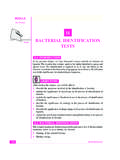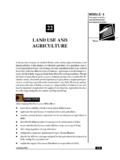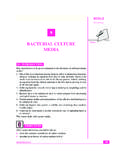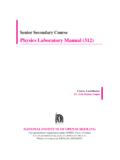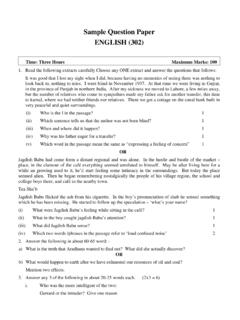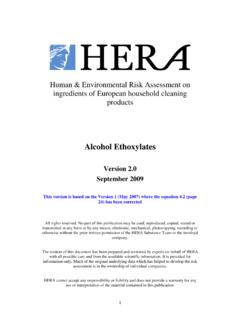Transcription of PRINCIPLES OF ECOLOGY
1 49 PRINCIPLES of EcologyNotesMODULE - 2 Ecological Conceptsand Issues4 PRINCIPLES OF ECOLOGYIn the previous module (module-1) you have learnt about the origin and evolution of theenvironment. You have also learnt how humans have been interacting with the this lesson, which is the first one in the module-2, you will learn some important conceptsof ECOLOGY which is an established branch of science. OBJECTIVESA fter completing this lesson, you will be able to: define the term ECOLOGY ; explain the relationship between organism and its habitat with a special mentionof the human species; recognize the levels of ecological organizations from organism (individual) topopulation, community, ecosystem, biome and biosphere; differentiate between habitat and niche; describe the concept of species and explain the basic idea of adaptation, evolutionand extinction; explain the concept of population with reference to organisms; highlight the characteristics of size, growth, density and dispersion of population; analyze the demographic factors influencing the changes in population oforganisms.
2 Explain community structure with reference to species diversity, interspecificinteractions and ecological succession. DEFINITION OF ECOLOGY ECOLOGY may be defined as the scientific study of the relationship of livingorganisms with each other and with their environment. Environmental Science Senior Secondary CourseNotes50 MODULE - 2 Ecological Conceptsand IssuesThe term ECOLOGY was first coined in 1869 by the German biologist Ernst Haeckel. It hasbeen derived from two Greek words, oikos , meaning home or estate and logos meaningstudy. The emphasis is on relationships between organisms and the components of theenvironment namely abiotic (non-living) and biotic (living). LEVELS OF ECOLOGICAL ORGANIZATIONE cology not only deals with the study of the relationship of individual organisms with theirenvironment, but also with the study of populations, communities, ecosystems, biomes,and biosphere as a whole (see Fig.)
3 Fig. : Levels of ecological organization and types of ecological studiesI. Study of physical andbiological features of aparticular Study of human activitiesaffecting the earth like globalclimate, ozone hole large community unit, characterized by a majorvegetation type and associated fauna, found in a specificclimatic region is a biomeBiomes refer basically to terrestrial areas. The aquaticsystems like the seas, rivers etc. are also divided intodistinct life zones on basis of ofLevels ofecologicalorganization1. Organisms(individual)basic unit ofstudy2. PopulationA group of organismsconsisting of a numberof different populationsthat live in defind areaand interact with CommunityA group of organismsconsisting of anumber of differentspecies that live inan area and interactwith each other4.
4 EcosystemA communities oforganisms and theirphysicalenvironment,interacting as anecological ofstudyStudy of the form,physiology, behavior,distribution andadaptation oforganism in relationto ofinteraction betweenpopulations of structureand compositionof community andinterspecificinteractionsbetween membersof of thecommunity in relationto the structure of itsecosystem-nutrientscycling, climate,energy flow of EcologyNotesMODULE - 2 Ecological Conceptsand Issues HABITAT AND ORGANISMH abitat is the physical environment in which an organism lives. Each organism has particularrequirements for its survival and lives where the environment provides for those environmental requirement of an elephant would be a forest. You would not expect anelephant in the ocean nor would you expect a whale in the forest?
5 A habitat may supportmany different species having similar requirements. For example, a single ocean habitatmay support a whale, a sea-horse, seal, phytoplankton and many other kinds of various species sharing a habitat thus have the same address . Forest, ocean, riveretc. are examples of features of the habitat can be represented by its structural components namely (1)space (2) food (3) water (4) and cover or shelter (Fig. ).Earth has four major habitats-(1) Terrestrial (2) Freshwater (3) Estuarine (Whererivers meet the ocean) and (4) Ocean. The human gut is the habitat of a tapeworm and therotting log a habitat of a : Structural components of a habitat NICHE AND ORGANISMIn nature, many species occupy the same habitat but they perform different functions. Thefunctional characteristics of a species in its habitat is referred to as niche in that commonhabitat.
6 Habitat of a species is like its address ( where it lives) whereas niche can bethought of as its profession ( activities and responses specific to the species). Theterm niche means the sum of all the activities and relationships of a species bywhich it uses the resources in its habitat for its survival and niche is unique for a species while many species share the habitat. No two species in ahabitat can have the same niche. This is because if two species occupy the same niche theywill compete with one another until one is displaced. For example, a large number ofWaterSpaceFoodShelter orcoverEnvironmental Science Senior Secondary CourseNotes52 MODULE - 2 Ecological Conceptsand Issuesdifferent species of insects may be pests of the same plant but they can co-exist as theyfeed on different parts of the same plant.
7 (Fig. ).Fig. : Different species of insects feeding on different parts of the same plantAnother example is the vegetation of the forest. The forest can support a large number ofplant species as they occupy different niches: the tall trees, the short trees, shrubs, bushesand grasses are all part of the forest but because of varying heights they differ in theirrequirements for sunlight and nutrients and so can survive together (Fig. )Fig. : The three species of warbler birds search for insects as food in the forestat different levels in the tree and so occupy different nichesLacebugShootmothlarvaSerpentinelea f minersRoot-feeding white grubBay-breasted warblerByrtle warblerBlackburnian warbler53 PRINCIPLES of EcologyNotesMODULE - 2 Ecological Conceptsand IssuesAnt, insectFruitLionCowOyster snailFishWhaleFoxHenGrassGoatThe most important resources in the niches of animals are food and shelter while in case ofplants, they are moisture and nutrients (phosphorous and nitrogen).
8 Fig. shows theniche of human : The ecological niche of human being INTEXT QUESTIONS does the term ECOLOGY mean? the term one point of difference between habitat and ADAPTATIONE very organism is suited to live in its particular habitat. You know that the coconuts cannotgrow in a desert while a camel cannot survive in an ocean. Each organism is adapted to itsparticular environment. An adaptation is thus, the appearance or behaviour orstructure or mode of life of an organism that allows it to survive in a particularenvironment . Presence of gills and fins are examples of adaptation in fishes to aquatichabitat. In aquatic flowering plants absence of wood formation and highly reduced rootCrabEnvironmental Science Senior Secondary CourseNotes54 MODULE - 2 Ecological Conceptsand Issuessystem are adaptations to aquatic environment.
9 Adaptations that can be observed in structure(Fig. ) or behaviour or physiology of an organism. Adaptations have genetic basis andhave been produced and perfected through evolution. This means that the adaptions havedeveloped over many generations to help a species survive successfully in its of basic adaptations that help animals and plants to survive in their respectiveenvironments. Shape of bird s beak. The thickness or thinness of fur. Presence of feathers and wings in birds. Evergreen and deciduous nature of trees. Presence and absence of thorns on leaves and : Adaptation in the types of beaks in birds: The beaks of different birds areadopted for feeding on different kinds of food What is a SpeciesA species is defined as; a group of similar populations of organisms whose members arecapable of interbreeding, and to produce fertile offspring (children).
10 A tiger, a lion, a lotusand a rose are examples of different species. Every species has a scientific name, understoodby people of all over the world. Humans belong to species of Homo sapiens. Onlymembers of the same species can interbreed to produce fertile offspring. Every specieshas its own set of genetic characteristics that makes the species unique and different fromother species. VariationHowever, species are generally composed of a number of distinct populations which freelyinterbreed even though they appear to be different in long thin beak is useful forpulling worms out of mudThe strong beak of parrot isuseful for curshing nutsThis flat beak helps in feeding onfish, insects and plants in water55 PRINCIPLES of EcologyNotesMODULE - 2 Ecological Conceptsand IssuesDifference in colour of skin, type of hair; curly or straight, eye colour, blood type amongdifferent ethnic groups represent variation within human species.
